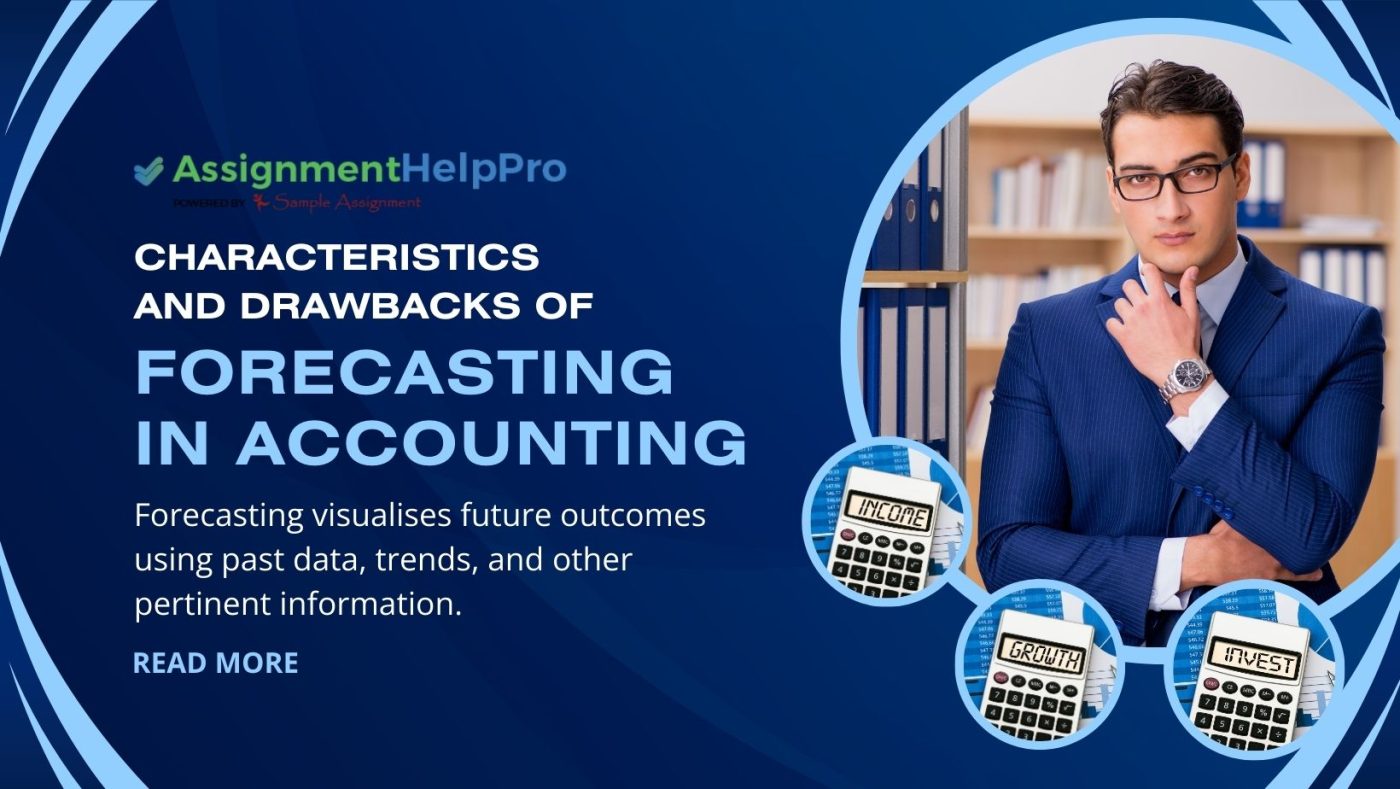What are the traits and downsides of forecasting in accounting?
Forecasting visualises future outcomes utilizing previous knowledge, developments, and different pertinent info. Accounting generally makes use of it to foretell future monetary efficiency, equivalent to gross sales revenues, bills, money flows, and profitability. Its approaches fluctuate primarily based on the realm of consideration, however some typical strategies embody time sequence evaluation, regression evaluation, and econometric modelling. Forecasting is a vital task matter for accounting college students since it’s a baseline for evaluating precise efficiency to predictions. Organizations might improve forecasting accuracy and decision-making by evaluating anticipated outcomes to precise outcomes. However, college students discover the subject difficult and therefore wrestle with the assignments. Accounting assignment help providers are important in aiding college students with forecasting assignments by offering skilled accounting professionals and material consultants with personalised steering and help, permitting college students to grasp complicated forecasting ideas and methods.
Characteristics of forecasting
Forecasting is a dynamic course of that makes use of previous knowledge, developments, and different pertinent elements to foretell future occasions. Here are some key options of predicting.
Data-driven
Forecasting in accounting and finance makes use of historic knowledge and present information to anticipate future developments and outcomes. Sales data, monetary accounts, market analysis, financial indicators, and different associated knowledge units are all potential knowledge sources.
Quantitative and Qualitative
Forecasting methods may be quantitative (utilizing mathematical fashions and statistical evaluation) or qualitative (incorporating skilled judgment and subjective assessments). The selection of approach is predictable by the information sort and the forecasting problem’s complexity.
Forward-Looking
Forecasting goals to forecast future occurrences or developments slightly than analyzing previous efficiency in accounting and finance. It entails extrapolating historic knowledge to detect patterns or developments which might be more likely to proceed.
Uncertainty and Risk
Forecasting acknowledges the inherent uncertainty and threat in predicting future outcomes. While projections can present invaluable insights into possible future conditions, they’re liable to errors and uncertainty owing to elements equivalent to market volatility, unanticipated occasions, and modifications in underlying assumptions.
Time Horizon
Forecasts can have a variety of time horizons, from short-term (month-to-month or quarterly) to long-term (annual or multi-year). The exact forecasting function and the information sort being evaluated decide the temporal horizon in accounting and finance.
Continuous Monitoring and Updating
Forecasts should not static; they’re always monitored and up to date as new info turns into accessible and circumstances change. Forecasts are reviewed and revised frequently, permitting firms to react to altering market circumstances and appropriately modify their plans and techniques.
Purpose-driven
Forecasting contains strategic planning, monetary budgeting, operational decision-making, threat administration, and efficiency evaluation. The forecast’s goal determines accounting and finance approach, element stage, and evaluation scope.
Accuracy and Reliability
The accuracy and reliability of forecasts are decided by the standard of the information, the appropriateness of the forecasting approach, and the ability of the forecasters. While no forecast is flawless, makes an attempt are made to scale back errors and biases by way of rigorous analysis and validation.
Drawbacks of forecasting
While forecasting is a necessary instrument in accounting and finance for anticipating future occurrences and making choices, it additionally has a number of downsides and limits. Here are a few of the frequent disadvantages of forecasting in accounting:
Uncertainty and Inaccuracy
Forecasting entails forecasting future occasions utilizing previous knowledge and assumptions about future conditions. However, future occasions are essentially unpredictable in accounting and finance, and forecasts could also be incorrect owing to sudden modifications in market circumstances, financial issues, or company circumstances.
Complexity and Assumptions
Forecasting regularly necessitates making simplified assumptions and using sophisticated mathematical fashions to forecast future developments. These assumptions might fail to precisely mirror the underlying dynamics of the enterprise or the exterior atmosphere, leading to forecast inaccuracies.
Data Limitations
Forecasting makes use of historic knowledge to make predictions. However, historic knowledge could also be insufficient or incomplete, particularly for brand spanking new or quickly evolving companies, making it troublesome to make dependable predictions.
Bias and Subjectivity
Forecasts will be influenced by biases and subjective judgments, primarily after they depend on skilled opinions or qualitative assessments. These biases in accounting and finance would possibly lead to overestimating or underestimating future outcomes, skewing decision-making.
Overreliance
Depending too closely on projections can result in overconfidence and complacency, as decision-makers might imagine that future outcomes are particular or predictable. This can result in poor decision-making and an incapacity to regulate to altering circumstances.
Lack of Flexibility
Forecasts are regularly primarily based on outlined assumptions and durations, which can not present sufficient flexibility to account for modifications within the enterprise atmosphere or unexpected occasions. This lack of flexibility would possibly limit the utility of forecasts in dynamic and unsure conditions.
Cost and Resource Intensive
Accurate forecasting calls for vital time, assets, and ability. Small enterprises or organizations with restricted assets might wrestle to dedicate the assets required to conduct complete forecasting efforts.
Difficulty in Measuring and Validating Results
Forecasting outcomes will be difficult to measure and validate, particularly for long-term forecasts or projections of intangible traits like buyer behaviour or market temper. This makes it troublesome to judge the accuracy and reliability of forecasts over time.
Potential for Manipulation
Forecasts will be adjustable and selectable to help numerous organisational targets or pursuits. This can erode the boldness and integrity of the forecasting course of, leading to poor decision-making in accounting and finance.
Despite these shortcomings, forecasting stays a essential accounting instrument for guiding planning, budgeting, and decision-making processes. Organizations can improve the accuracy and utility of their forecasts whereas minimizing potential detrimental penalties by understanding forecasting limits and making use of threat administration measures.
Conclusion
Forecasting is an important accounting approach that permits companies to foretell future outcomes and make knowledgeable choices primarily based on previous knowledge and patterns. Despite its usefulness, forecasting has inherent downsides, equivalent to unpredictability, complexity, and the potential of bias.
However, understanding forecasting is significant for accounting college students as a result of it permits them to construct essential pondering talents and apply theoretical ideas to real-world conditions. Forecasting is a vital task matter that permits college students to enhance their understanding of accounting ideas and procedures whereas additionally buying essential talents for future success within the area. Accounting assignment help pro help college students with forecasting duties by giving skilled teaching, personalised options, and high quality assurance, permitting them to thrive academically and put together for future employment in accounting and finance.



